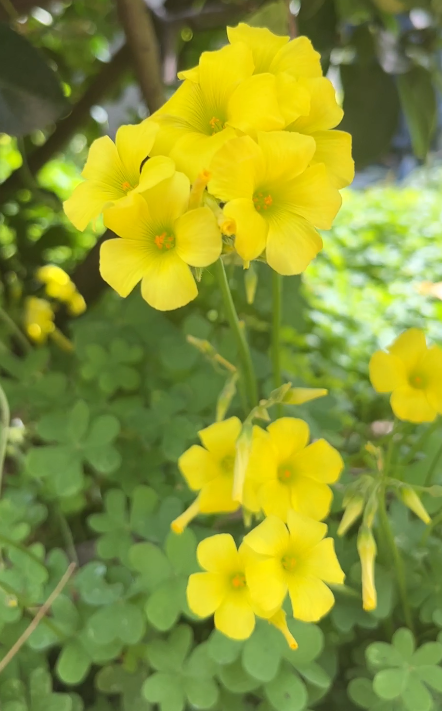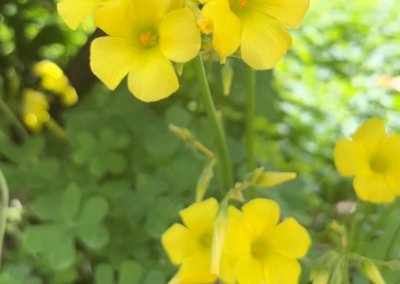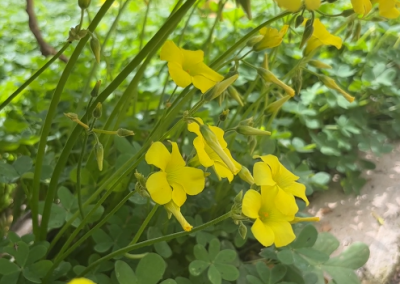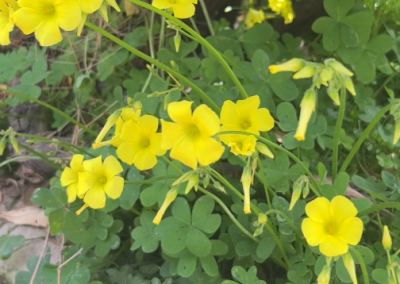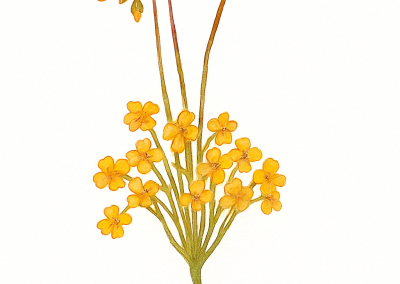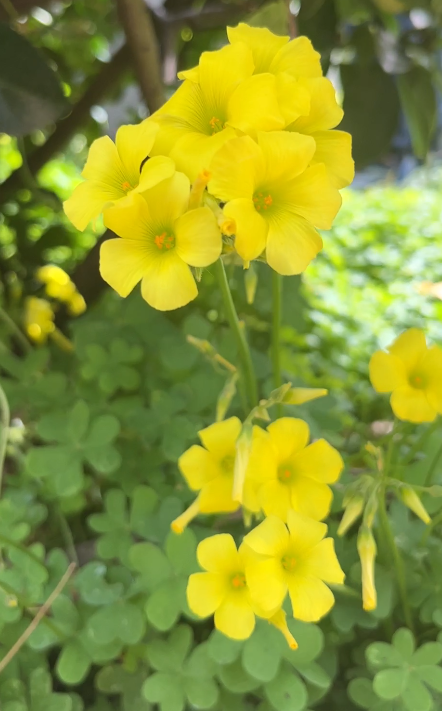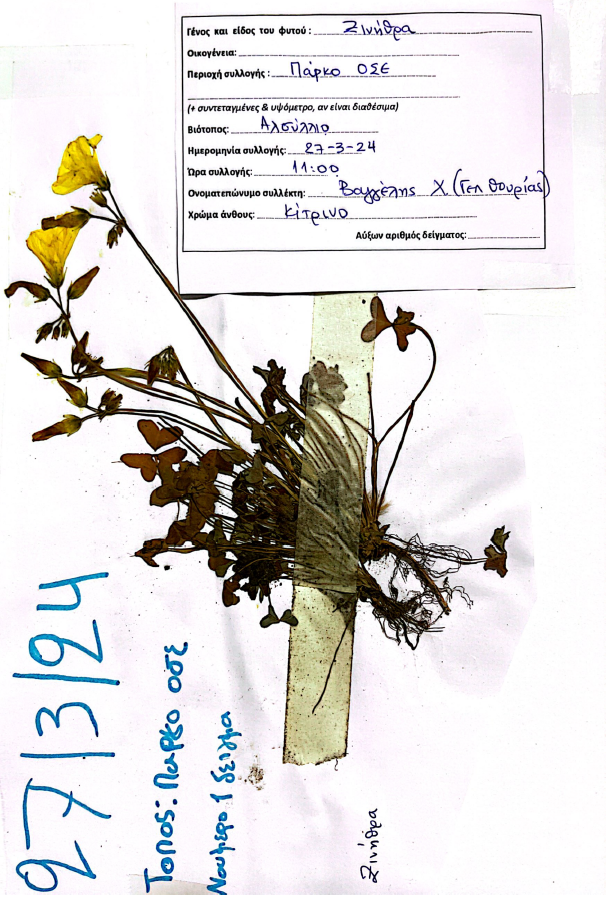Oxalis pes – caprae L.
Scientific description
Scientific name: Oxalis pes-caprae L.
Kingdom: Plantae | Clade: Tracheophytes, Angiosperms, Eudicots, Rosids | Order: Oxalidales | Family: Oxalidaceae | Genus: Oxalis | Species: O. pes-caprae
Origin: South-African geophyte introduced worldwide as an ornamental plant; now a widespread invasive weed in Mediterranean climates.
Description: Perennial herb, spreading widely, shallow stake-like roots forming small tubers, smooth stem 5–30 cm tall. Leaves compound with 3 heart-shaped leaflets, grey-green, lobed, hairy. Flowers hermaphrodite, lemon-yellow, 6–12 per inflorescence on long hairless pedicel. Fruit rarely formed, brown capsule.
Ecology: Mediterranean climate, mild rainy winters, hot dry summers; temperate, tropical, subtropical climates. Weed in cultivated and uncultivated fields, gardens, wet woodlands, roadsides, rubbish tips. Flowering December–May. Indicator of calcium-deficient soils.
Propagation: Mainly by bulbils, occasionally by seed; spreads rapidly.
Usage: Culinary: small quantities in salads, sauces, herb pies (pleasant sour taste). Leaves and shoots harvested winter/spring; contains potassium oxalate/oxalic acid (toxic in large amounts; cooking reduces toxicity). Apiculture: nectar/pollen source in winter. Medicinal: antiscorbutic, astringent, diuretic, emmenagogue, expectorant, antipyretic, irritant, stomachic. Leaf decoction for fevers and thirst; external poultice for abscesses, wounds, skin conditions, mucous irritation, cosmetic uses.
Επιστημονική ονομασία: Oxalis pes-caprae L.
Κοινές ονομασίες: Ξινήθρα, Oxinoudi, Ξινοτρίφυλλο, Ξινίδα, Οξαλίδα, Ξυνάκι
Βασίλειο: Plantae | Clade: Tracheophytes, Angiosperms, Eudicots, Rosids | Τάξη: Oxalidales | Οικογένεια: Oxalidaceae | Γένος: Oxalis | Είδος: O. pes-caprae
Καταγωγή: Νοτιοαφρικανικό γεώφυτο, εισαχθέν ως καλλωπιστικό. Έχει γίνει ευρέως διαδεδομένο χωροκατακτητικό ζιζάνιο σε περιοχές με μεσογειακό κλίμα.
Περιγραφή: Πολυετής έρπουσα πόα, με πασσαλώδεις ρηχές ρίζες που σχηματίζουν μικρούς κόνδυλους, λείο βλαστό 5–30 εκ., σύνθετα φύλλα με 3 καρδιοειδή φυλλάρια, γκριζοπράσινα, λοβωτά και τριχωτά. Άνθη ερμαφρόδιτα, λεμονί-κίτρινα, 6–12 ανά σκιάδιο, πάνω σε άτριχο μακρύ ποδίσκο. Ο καρπός σπάνια σχηματίζεται, καστανή κάψα.
Οικολογία: Μεσογειακό κλίμα, ήπιους βροχερούς χειμώνες, ζεστά ξηρά καλοκαίρια, εύκρατα, τροπικά, υποτροπικά κλίματα. Ζιζάνιο σε καλλιεργούμενα/μη αγρούς, κήπους, υγρά δάση, άκρες δρόμων, σκουπιδότοπους. Περίοδος ανθοφορίας: Δεκ–Μάι. Δείκτης ελλείψεων ασβεστίου στο έδαφος.
Πολλαπλασιασμός: Κυρίως με βολβούς, σε μικρότερο βαθμό με σπόρους.
Χρήση: Μαγειρική: μικρές ποσότητες σε σαλάτες, σάλτσες, χορτόπιτες. Συλλογή φύλλων και τρυφερών βλαστών Χειμ/Άνοιξη. Περιέχει οξαλικό κάλιο και οξαλικό οξύ. Μελισσοκομία: γύρη και νέκταρ το χειμώνα. Φαρμακευτική: αντισκορβουτική, στυπτική, διουρητική, εμμηναγωγική, αποχρεμπτική, αντιπυρετική, ερεθιστική, στομαχική. Αφεψήματα για πυρετό/δίψα, εξωτερικά κατάπλασμα σε αποστήματα, πληγές, δερματικές παθήσεις, ερεθισμούς βλεννογόνων, καλλυντικές χρήσεις.
Nom scientifique: Oxalis pes-caprae L.
Régne: Plantae | Clade: Tracheophytes, Angiospermes, Eudicots, Rosidées | Ordre: Oxalidales | Famille: Oxalidaceae | Genre: Oxalis | Espèce: O. pes-caprae
Origine: Géophyte sud-africaine introduite comme plante ornementale, devenue mauvaise herbe envahissante dans les climats méditerranéens.
Description: Plante herbacée vivace, étendue, racines peu profondes en piquets formant tubercules, tige lisse 5–30 cm. Feuilles composées de 3 folioles en cœur, gris-vert, lobées, poilues. Fleurs hermaphrodites, jaune citron, 6–12 par inflorescence, pédicelle long glabre. Fruit rarement formé, capsule brune.
Écologie: Climat méditerranéen (hivers doux et pluvieux, étés chauds et secs), climats tempérés, tropicaux, subtropicaux. Mauvaise herbe dans champs cultivés/non cultivés, jardins, bois humides, bords de routes, décharges. Floraison décembre–mai. Indique sols déficients en calcium.
Propagation: Principalement par bulbilles, secondairement par graines.
Utilisation: Culinaire: petites quantités dans salades, sauces, tartes aux herbes. Apiculture: nectar et pollen l’hiver. Médicinale: antiscorbutique, astringente, diurétique, emménagogue, expectorante, antipyrétique, irritante, stomachique. Décoction contre fièvre et soif; cataplasmes sur abcès, plaies, affections cutanées, irritations muqueuses, soins de beauté.
Denumire științifică: Oxalis pes-caprae L.
Regn: Plantae | Cladă: Tracheophyta, Angiosperme, Eudicotiledonate, Roside | Ordin: Oxalidales | Familie: Oxalidaceae | Gen: Oxalis | Specie: O. pes-caprae
Origine: Geofită sud-africană, introdusă ca plantă ornamentală, răspândită ca buruiană invazivă în regiunile cu climat mediteranean.
Descriere: Plantă erbacee perenă, răspândită pe suprafețe mari, rădăcini asemănătoare țărușilor, mici tuberculi, tulpină netedă 5–30 cm. Frunze compuse cu 3 foliole inimă, verde-cenușiu, lobate, păroase. Flori hermafrodite, galben-lămâie, 6–12 buchete, pedunculi lungi glabri. Fruct rar, capsulă brună.
Ecologie: Climat mediteranean, ierni blânde/ploiase, veri calde/uscat. Se adaptează și la climat temperate, tropical, subtropical. Perioada înflorire: Dec–Mai. Buruiană în terenuri cultivate/necultivate, grădini, păduri umede, margini drum, gropi gunoi. Indică soluri deficitare în calciu.
Înmulțire: Principal prin bulbili, secundar prin semințe.
Utilizări: Alimentar: cantități mici în salate, sosuri, plăcinte cu ierburi. Apicultură: nectar/polen iarna. Medicinal: antiscorbutic, astringent, diuretic, emmenagog, expectorant, antipiretic, iritant, stomacic. Decoction pentru febră/sete; cataplasme pentru abcese, răni, afecțiuni cutanate, iritații mucoase, tratamente cosmetice.
Creative writing inspired by Oxalis pes – caprae L.
Oxalis pes-caprae L.
Long ago, in a small village near the coast of ancient Greece, there was a young girl named Xinia, known for her radiant smile and joy for life. Her laughter was so infectious that it could lift the spirits of anyone around her. However, Xinia had a secret—though she always appeared cheerful, her heart was heavy with sadness over a lost love.
One day, wandering through the fields to clear her mind, Xinia found a small, delicate plant with clover-like leaves and bright yellow flowers. Intrigued by its beauty, she tasted the leaves and was surprised by the sharp, tangy flavor. The sourness of the plant, however, brought her a strange sense of relief, as if it mirrored the bittersweet feelings in her heart.
Unbeknownst to Xinia, the plant was sacred to Persephone, the goddess of the underworld and of spring. Sensing the girl’s sorrow, Persephone appeared to her, offering comfort. She explained that just as the plant bore both beauty and sourness, life too is a mix of joy and sorrow. She told Xinia that the plant, called "Oxalis," was a reminder that even in hardship, sweetness could be found.
Persephone then gave Xinia a blessing: whenever she felt sadness, the taste of the Oxalis leaves would cleanse her spirit, reminding her that every trial in life would eventually pass, like winter giving way to spring. Xinia spread the plant throughout the village, and soon everyone began to call it "Xinithra," after the girl who found solace in its sour taste.
Over time, Xinithra, or Oxalis pes-caprae, became a symbol of resilience. Though its leaves had a sour flavor, they represented the idea that life’s hardships could be embraced, leading to inner strength and peace. The bright yellow flowers, blooming in winter, reminded people that light could always be found, even in the darkest of times.


